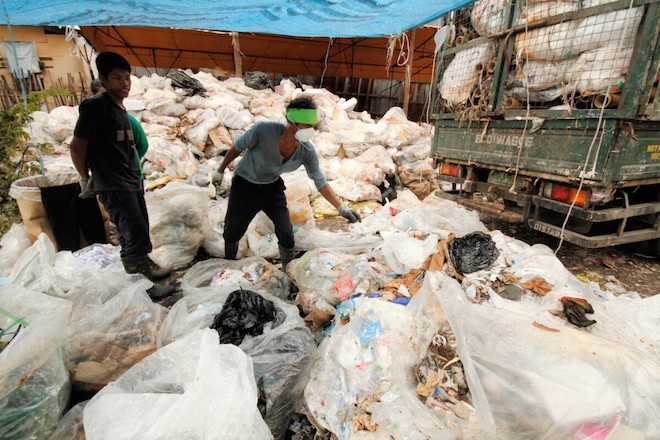
The transition to a circular economy is crucial to attaining the ASEAN Community Vision 2025 of “vibrant, sustainable, and highly integrated economies.”
Rapid urbanization and industrialization have transformed the Southeast Asian bloc into a production and consumption powerhouse with an increasingly prosperous population. However, the current economic model of “take, make, dispose” is unsustainable.
According to an ASEAN policy brief on the circular economy transition, “the region’s growth led to a rapid increase in carbon emissions, from 1,038 metric tons (Mt) of carbon dioxide (CO2) in 2010 to 1,429 Mt CO2 in 2018.”
The good news is that carbon emissions per unit of GDP stabilized or declined in most of the 10 member states as they develop and transition into a service economy, which emits less carbon. However, the report says emissions per capita are on an uptrend in all countries, except for Brunei Darussalam and Singapore. This is especially true in cities, which “foster more energy-intensive and consumerist lifestyles.”
Multiple benefits
In October 2021, ASEAN adopted the Framework for a Circular Economy to scale up and accelerate the shift to a low-carbon economy. This is expected to help member states achieve their climate goals and attain a green and resilient recovery from the COVID-19 pandemic.
A circular economy promotes responsible consumption and production practices by adopting such principles as reduce by design and value retention (e.g., recycle, reuse, repurpose). It is expected to have multiple benefits, including lowering emissions, reducing waste generation and pollution, lessening the need for natural resource extraction, increasing employment opportunities, and contributing to several Sustainable Development Goals.
In 2017, the Economic Research Institute for ASEAN and East Asia (ERIA) estimated that shifting to a circular economy could “lead to economic growth of $324 billion and create 1.5 million jobs” across Asia, particularly in manufacturing and in the agriculture and forestry sectors, in 25 years.
Priorities for regional cooperation
Under the framework, ASEAN has set five strategic priorities:
- standard harmonization and mutual recognition of circular products and services;
- trade openness and trade facilitation in circular goods and services;
- enhanced role of innovation, digitalization, and emerging/green technologies;
- competitive sustainable finance and innovative ESG investments; and
- efficient use of energy and other resources.
A policy brief from the Asian Development Bank (ADB) notes that the strong economic integration in Southeast Asia makes it imperative to formulate and coordinate circular economic policies at the regional level. For example, ASEAN countries need to agree on the definition of circular products and services as well as address potential barriers to their trade and to the diffusion of circular technologies across the region.
The ASEAN policy brief says that “at the regional level, strategic measures have to be broad and flexible to cover the diverse priorities and levels of development of member states; practical enough for the private sector to adopt; and relatable to the public.”
Inclusive approach
According to the United Nations Environment Programme (UNEP), for the transition to a circular economy to be successful, it must promote not only the conservation of the environment but also the well-being of all.
The ASEAN policy brief sees the transition as “a long-term multi-sectoral and multi-stakeholder process.” It needs the strong support of the private sector and the public.
The policy brief suggests that “governments can build on the efforts made by the private sector, especially multinationals which are at the forefront of the circular economy transition, and employ citizen engagement for a more informed policymaking. Sectoral and public consultations also serve as a means of getting businesses and people interested and involved in the circular economy transformation.”
This article was first published by BIMP-EAGA on 28 March 2023.

